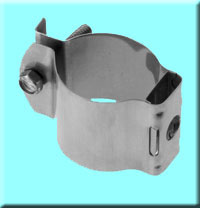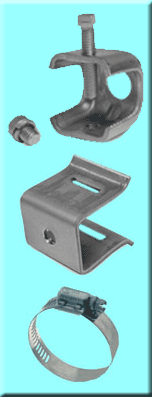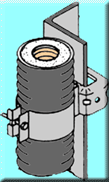
Installation Information
Standard Hanger Kits
Installing a standard butterfly hanger requires attaching the rear of the hanger with a phillister 3/8x 3/4” or 1” bolt, lock washer and nut to a pre-punched 7/16” opening on a fixed cable support system or ladder. For applications that do not have a fixed mounting bracket, an angle adaptor can be mounted directly to flat members. For attachment to a round member, a tower standoff can be used which will be attached with a hose clamp. The hanger is hand molded around the transmission line and the locking bolt and nut are put in place. There should be approximately 5/16” of an opening when the hanger is secured. Tightening the hanger too tight can cause damage to the outer conductor and result in VSWR degradation. Cable hangers are not meant to provide full support of the weight of the cable. Hoisting grips perform this function. Cable hangers are designed to keep the cable in a fixed position on the structure. phillister 3/8x 3/4” or 1” bolt, lock washer and nut to a pre-punched 7/16” opening on a fixed cable support system or ladder. For applications that do not have a fixed mounting bracket, an angle adaptor can be mounted directly to flat members. For attachment to a round member, a tower standoff can be used which will be attached with a hose clamp. The hanger is hand molded around the transmission line and the locking bolt and nut are put in place. There should be approximately 5/16” of an opening when the hanger is secured. Tightening the hanger too tight can cause damage to the outer conductor and result in VSWR degradation. Cable hangers are not meant to provide full support of the weight of the cable. Hoisting grips perform this function. Cable hangers are designed to keep the cable in a fixed position on the structure.
The time that it will take to install a hanger kit and secure the transmission line will vary depending upon the number of cables being dressed and the attachment structure. The ideal situation would be to have six transmission lines coming down one waveguide ladder face with picture perfect weather. However, to enjoy a minimized wind loading, the installation might require installing two or three cables per leg with hose clamps and standoff brackets. A tower technician might average securing the line with 50 hangers per hour. The default pricing is based upon the installaton of a single standard hanger. and the attachment structure. The ideal situation would be to have six transmission lines coming down one waveguide ladder face with picture perfect weather. However, to enjoy a minimized wind loading, the installation might require installing two or three cables per leg with hose clamps and standoff brackets. A tower technician might average securing the line with 50 hangers per hour. The default pricing is based upon the installaton of a single standard hanger.
We recommend that you contact our valued antenna and line installation companies to obtain additional information about their services, capabilities and experience.
|